Sony F1022015 Licensed transmitter User Manual Josephine SHUG
Sony Mobile Communications Inc Licensed transmitter Josephine SHUG
Sony >
Contents
- 1. 08 user guide part 1
- 2. 08 user guide part 2
- 3. 08 user guide part 3
08 user guide part 3
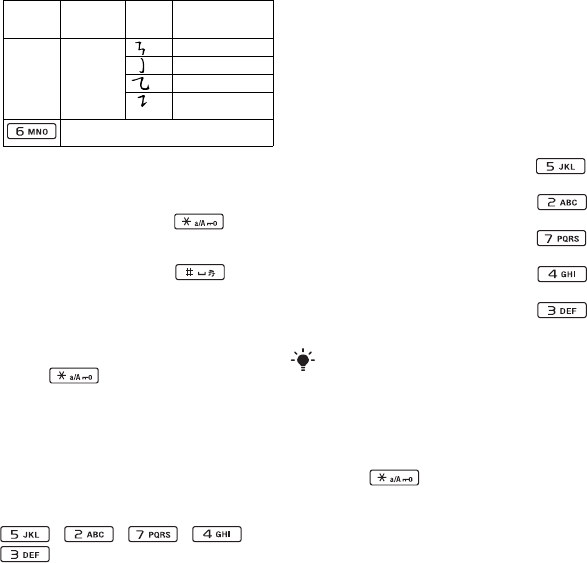
24 Getting to know the phone
Draft for Sony Ericsson Internal Use Only
To switch between keypad
prediction and handwriting
recognition
•Press and hold down .
To switch input languages
•Press and hold down .
To switch between upper case
and lower case
1Select English as the input
language.
2Press .
To enter the word “large“ using
keypad prediction
1Switch to keypad prediction
mode.
2Select English as the input
language.
3Enter word "large" by pressing
, , , ,
.
4Select the word "large" from the
candidate list.
To enter the word "large" using
multitap
1Switch to handwriting recognition
mode.
2Select English as the input
language.
3Enter letter "l" by pressing
three times.
4Enter letter "a" by pressing
once.
5Enter letter "r" by pressing
three times.
6Enter letter "g" by pressing
once.
7Enter letter "e" by pressing
twice.
To switch between Chinese input
methods
1Select Chinese as the input
language.
2Press .
凸
狗 豹 家 逐 狂
乙 九 瓦 飞 风
话 计 认 讯
? (
Wild card key)
Number
Key
Stroke
Category
Basic
Stroke
Example
You cannot use multitap under
keypad prediction mode.
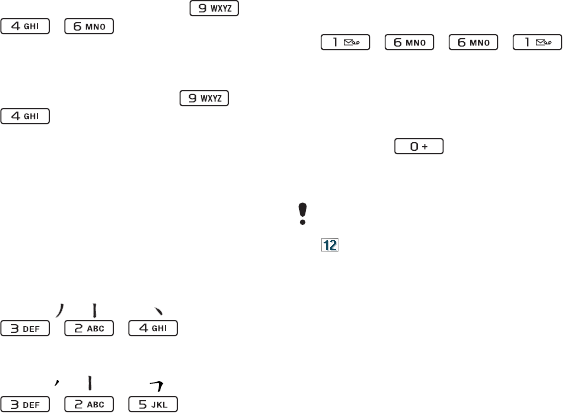
25Getting to know the phone
Draft for Sony Ericsson Internal Use Only
To enter "
信息
" using Pinyin input
1Select Chinese as the input
language.
2Select Pinyin as the input method.
3Enter "xin" by pressing ,
, .
4Select "xin" using the navigation
key, and then select "
信
" from the
candidate list.
5Enter "xi" by pressing ,
.
6Select "xi" using the navigation
key, and then select "息" from the
candidate list.
To enter "
信息
" using Stroke
input
1Select Chinese as the input
language.
2Select Stroke as the input
method.
3Enter " ", " " and " " by pressing
, , .
4Use the navigation key to select "
信".
5Enter " ", " " and " " by pressing
, , .
6Select " 息" from the candiate list.
To enter "
互
" using the wild card
key
1Select Chinese as the input
language.
2Select Stroke as the input
method.
3If you only know that " 一" is the
first and the last stroke of the
character " 互" and that the total
number of strokes is four, enter
, , , .
4Select " 互" from the candidate
list.
To enter symbols
1Open the symbol table by
pressing .
2Use the navigation key to select a
symbol.
This function is not available when
you are under number input mode
.
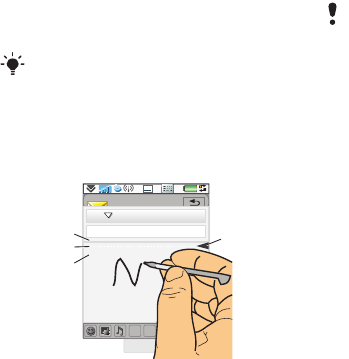
26 Getting to know the phone
Draft for Sony Ericsson Internal Use Only
Entering text using handwriting
recognition
Handwriting recognition translates
stylus gestures written directly on
the screen into letters, numbers or
other characters, and displays
these characters as text.
For more information, see To
switch between keypad prediction
and handwriting recognition on
page 24.
The handwriting input mode
screen consists of an upper and a
lower part divided by an arrow in
the middle on the right edge.
•1 – arrow that splits the text mode
screen into an upper part and a
lower part.
•2 – area to write the digits and
symbols.
•3 – area to write upper case letters
and Chinese characters.
•4 – area to write lower case letters
and Chinese characters.
To write Chinese characters
1Select Chinese as the input
language.
2Write Chinese characters below or
in line with the arrow. You can
select characters from the
candidate word list.
You cannot use keypad prediction
under handwriting mode.
a
A
A
123
SMS
2
4
31
To
Dan
Done More
Most letters can be written through
different stroke patterns. The upper
case and lower case depend on the
location on the screen, and are
unrelated to the pattern.
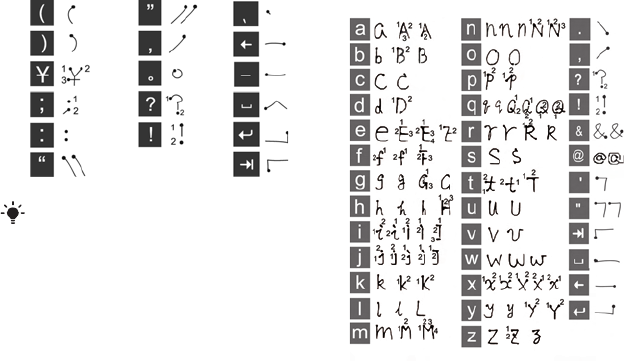
27Getting to know the phone
Draft for Sony Ericsson Internal Use Only
To write Chinese punctuation
1Select Chinese as the input
language.
2Write Chinese punctuation below
or inline with the arrow.
To write latin letters
1Select English as the input
language.
2Write lower case letters below the
arrow; upper case letters in line
with the arrow.
Start each stroke at the dotted end.
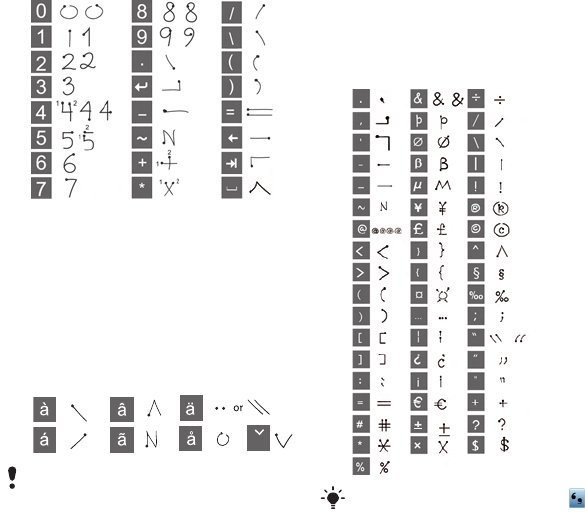
28 Getting to know the phone
Draft for Sony Ericsson Internal Use Only
To write numbers
•Write numbers above the arrow.
To write accented letters
1Select English as the input
language.
2Write the basic letter, and then
write the accent to form the
accented letter. For example, to
enter character "à", write "a"
below the arrow, followed with a
backward slash "\" above "a".
To write extended characters
1Select English as the input
language.
2Draw a slash mark "/" from bottom
up, followed with an extended
character below the arrow. For
example, to input "%", write "/%"
below the arrow.
You can only write accented
characters under Single-character
recognition.
S
You can also tap symbol icon and
select often-used symbols using your
stylus.
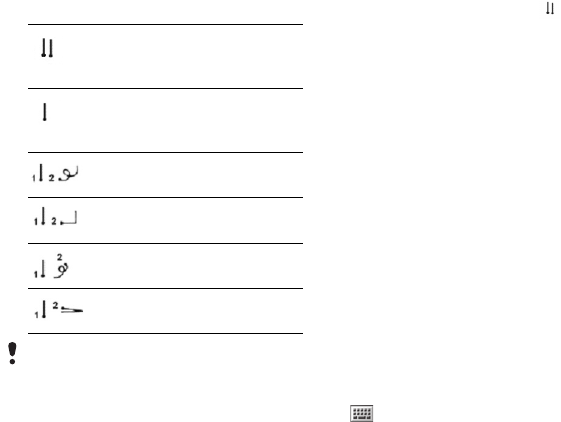
29Getting to know the phone
Draft for Sony Ericsson Internal Use Only
To use special gestures
•Use special gestures to perform
functions like deleting characters
and entering spaces.
To use multi-character
recognition
1Switch to multi-character
recognition by drawing .
2You can enter several characters
at one time. For example:
•Write one English word like
"hello" under English input
mode.
•Write several Chinese
characters like " 你好 " under
Chinese input mode.
•Write several digits like
"12345678" under any input
mode.
Entering text using on-screen
keyboard
The on-screen keyboard enables
you to select characters and
symbols with the stylus. The on-
screen keyboard can be set to
different languages.
To use the on-screen keyboard
1Tap the on-screen keyboard icon
located in the status bar.
2Use your stylus to use the on-
screen keyboard.
Switch between single-
character and multi-
character recognition.
Switch between Chinese
and English input
languages.
Cut highlighted text.
Copy text.
Paste text.
Undo an action.
For more information on how to
highlight text, go to To highlight
the text with the stylus on page
30.

30 Getting to know the phone
Draft for Sony Ericsson Internal Use Only
Editing text
When in text entry mode, you can
select More > Text options to find
more options.
To highlight the text with the
stylus
•Hold the stylus at the end of the
text for a short while then drag the
stylus across the text.
To activate word suggestion
•When in text entry mode, select
More > Text options > Word
suggestions.
You need to highlight text first before
using copy or cut functions.
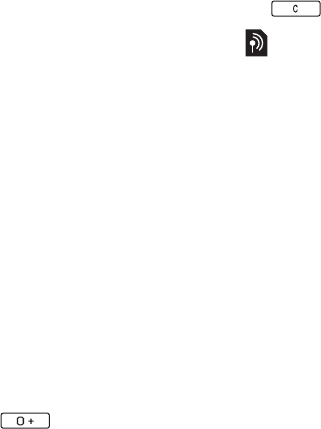
31Calling
Draft for Sony Ericsson Internal Use Only
Calling
Networks
Network coverage
To make or receive a phone call
your phone must be within range
of a network.
Network settings
You can set how your phone
should choose an available
network when you are outside
your operator’s coverage area.
From Standby you find the
settings in Main menu > Settings >
Connectivity > Mobile networks.
Making a call
To make a call from Standby
•Enter the phone number
(including the area number) on the
keypad and select Call.
To make an international call
1From Standby press and hold
down to get the
international call prefix.
2Enter the country/region code,
area code (without the first zero)
and phone number.
3Select Call.
To delete characters when
dialling
•When entering a number you can
delete characters by pressing
.
Hide or show your phone number
When calling, you can choose in
the More menu whether to show
or hide your phone number to the
called party.
Speed dial
You can save up to nine of your
contacts as Speed contacts
.
This
means that you can call them
using abbreviated numbers
(numbers 1 – 9).
To set a speed contact (number)
1From Standby select Main menu >
Organizer > Speed contacts.
2Scroll to an empty position and
select Add.
3Select a contact in the list and
select Save.
To make a call to a speed
contact
1From Standby press one of the
keys 1 to 9 that corresponds to
the stored speed contact.
2Select Call.

32 Calling
Draft for Sony Ericsson Internal Use Only
To make an emergency call
1From Standby, enter the
emergency number on the
keypad.
2Select Call.
Local SOS numbers
When dialling, you can find local
SOS numbers in the More menu.
Receiving a call
To answer a call
•Select Yes.
To reject a call with busy tone
•Select No.
Rejecting a call with an SMS text
message
This feature means that you can
reject a call by sending a pre-
defined SMS text message to the
caller. Before you use it, enter the
settings from Standby in Main
menu > Settings > Calls > Reject
with SMS. (You will be charged by
your operator for the SMS
message.)
To enable the speakerphone
•During a call, select More >
Speakerphone on.
To mute the microphone
(shortcut)
•During a call, press and hold
down .
To un-mute the microphone
(shortcut)
•When the microphone is muted,
press .
Handling two or more
calls
You can handle multiple calls at
the same time:
•Put an ongoing call on hold and
start a new one, or answer an
incoming call.
•Start a conference call during
an ongoing call (operator-
dependent).
•Extract one party in a
conference call for a private talk
and put the conference call on
hold.
•Retrieve a held call, or end it.
Usually no SIM card or PIN code is
required for emergency calls, but this
can be operator-dependant. Contact
your operator for more information.

33Calling
Draft for Sony Ericsson Internal Use Only
Conference call
You can start a conference call if
you have one active call and one
on hold. The maximum number of
conference parties is five.
To make a conference call
1Make a call and select Hold.
2Repeat the above step for each
party.
3Select More > Start conference
call.
Call log
You can find call information,
such as the type of call, time,
date, phone number and call
length, in Main menu > Calls. You
can also make a call or a call note
directly from this application.
Handsfree
If you connect a handsfree or a
Bluetooth™ headset to your
phone, you will need to set how to
answer an incoming call. From
Standby select Main menu >
Settings > Calls > Handsfree.
More features
Some of the features that your
phone supports can be found in
Main menu > Settings > Calls:
•Accept calls – caller filter.
•Add to contacts – add contact
data from the last call.
•ALS – line settings, if your SIM
card supports two lines.
•Call meter – service to keep
track of your call costs.
•Calling cards – call via a calling
card server.
•Call waiting – option to get
alerted if there is another call on
the line.
•Divert calls – divert calls to
other numbers.
•Fixed numbers – only special
numbers can be called.
•Flag call – reject a call and set a
reminder to follow it up later.
•My number – option to save
your own number.
•Restrict calls – options to set
roaming and international call
restrictions.
•Textphone accessory – use of a
teletype writer.
•Voicemail – “answering
machine”.

34 Calling
Draft for Sony Ericsson Internal Use Only
•Voice control – you can call and
answer with voice commands.
Using contacts
To make a call using Contacts
1From Standby select Main menu >
Contacts and scroll to the desired
contact.
2Select View to open the entry.
3Scroll to the desired phone
number and select Call.
To find service numbers on the
SIM card
1From Standby select Main menu >
Contacts.
2Select More > View folder > SIM.
3Select More > Service numbers.
Creating contacts
To create a new contact
1From Standby select Main menu >
Contacts.
2Select More > New contact.
3You can enter contact data on
four tabs.
4Select Save.
Business card scanner
With Business card scanner you
can scan a business card and let
the phone add the contact details
to your contacts.
Many of these features are operator-
dependent and may not be available.
For more information about these,
and other features, see Calling and
Settings in the Web guide.
If you save your contacts’ phone
numbers in the international number
format, starting with +, you can call
directly from Contacts when you are
abroad.

35Calling
Draft for Sony Ericsson Internal Use Only
To scan a business card
1From Standby select Main menu >
Organizer > Business card scanner.
2Select Capture to activate the
camera.
3Take a picture of the business
card by pressing the camera
button. You can add the scanned
information to your contacts now
or you can do this later.
To add business card details to
Contacts
1Scan a business card, or open a
previously scanned card in Main
menu > Organizer > Business card
scanner > Browse.
2Select Process.
3Adjust the contact entry fields if
necessary.
4Select Save
Editing contacts
To add a field to a contact
1From Standby select Main menu >
Contacts.
2Scroll to a contact and select
More > Edit contact.
3Select More > Add field and mark
a field.
4Select Add.
To edit a contact on the SIM card
1From Standby select Main menu >
Contacts.
2Select More > View folder > SIM.
3Scroll to a contact and select
More > Edit contact.
To add a stored picture to a
contact
1From Standby select Main menu >
Contacts and scroll to a contact.
2Select More > Edit contact.
3Scroll to the Picture field and
select Edit.
4Choose Select and scroll to a
picture you want to add.
5Choose Select > Save.
To add a personal ringtone to a
contact
1From Standby select Main menu >
Contacts and scroll to the desired
contact.
2Select More > Edit contact.
3Select the audio tab .
4Scroll to the Ringtone: drop-down
menu and select Open > Find
sound.
5Scroll to the sound you want to
add.
6Choose Select.
7Select More > Save.
36 Calling
Draft for Sony Ericsson Internal Use Only
Managing contacts
To copy a contact to another
folder
1From Standby select Main menu >
Contacts and scroll to a contact.
2Select More > Add to > desired
folder.
To delete a contact
1From Standby select Main menu >
Contacts and scroll to a contact.
2Select More > Delete.
To copy contacts to the SIM card
1From Standby select Main menu >
Contacts.
2Mark the desired entries in
Contacts.
3Select More > Add to > SIM.
To copy contacts from the SIM
card
1From Standby select Main menu >
Contacts.
2Select More > View folder > SIM to
open the SIM card.
3Mark the desired entries.
4Select More > Copy to Contacts.
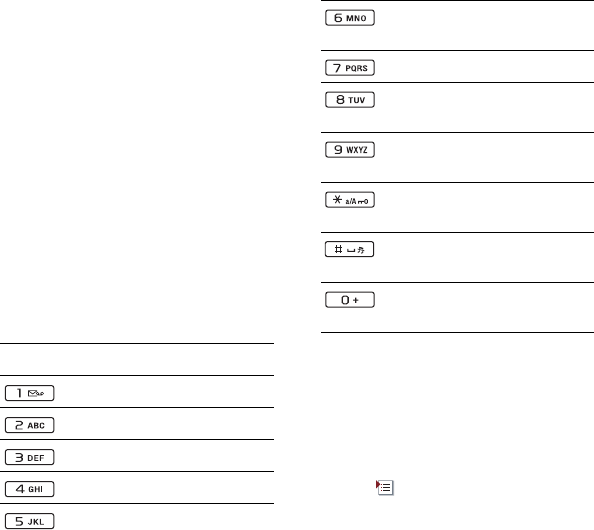
37Internet
Draft for Sony Ericsson Internal Use Only
Internet
Web
To use Web you need an Internet
connection. See
Setting up
Internet, email and MMS
in the
Web guide.
To start the Web browser
•From Standby select Main menu >
Web.
Navigation
All navigation commands and
settings are available from the
More menu. The most common
operations are also available as
keyboard shortcuts.
Settings
To switch to landscape view
•With Web open select More >
Settings and mark the Landscape
check box.
To exit landscape view
•Select > Settings and unmark
the Landscape check box.
Key Function
Go to Web page
Open the bookmarks list
Close the current page
Go to the homepage
Switch between loading
and not loading pictures
Switch between normal
and Full screen display
Switch to the next page
Open the Configuration
menu
Add a bookmark for the
current page
Find (on the Internet or on
the current page)
Go to the top or bottom of
the page
Stop or Reload the current
page

38 Internet
Draft for Sony Ericsson Internal Use Only
RSS feeds
RSS feeds allow you to see when
new content has been added to a
Web site. You can, for example,
get the latest headlines without
having to visit the Web site.
You can add feeds directly in the
RSS feeds application. An easier
way is to add feeds from within
the Web browser.
Before you use RSS feeds
To use RSS feeds you need an
Internet connection. See
Setting
up Internet, email and MMS
in the
Web guide.
To subscribe to an RSS feed
1From Standby select Main menu >
Entertainment > RSS feeds.
2Select More > Add feed and enter
the address to the feed.
3Select a folder to add the feed to.
To subscribe to an RSS feed
from the Web browser
1From Standby select Main menu >
Web.
2Navigate to a page that offers
RSS feeds.
3Select and choose between the
available feeds.
4Select a feed and which folder to
add it to.
To view an RSS feed
1From Standby select Main menu >
Entertainment > RSS feeds.
2Select a feed and select Open.
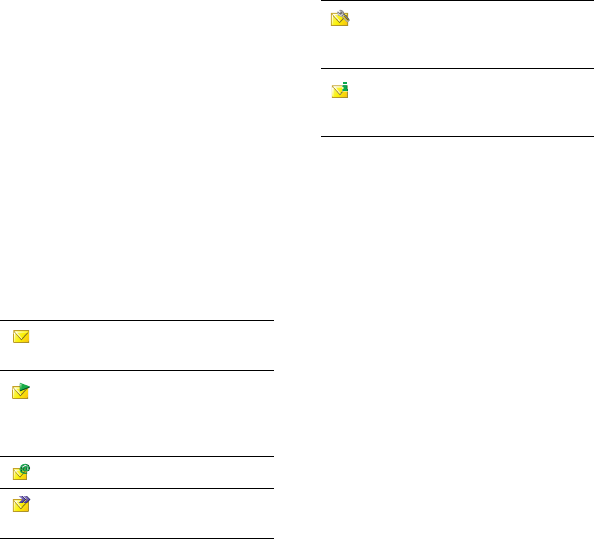
39Messaging
Draft for Sony Ericsson Internal Use Only
Messaging
Before you use
Messaging
Before you can send or receive
any messages (except for SMS
text messages) you need to set up
the necessary accounts. You can
use the Internet and Email wizards
provided in the phone to
download settings or do this
manually. See
Setting up Internet,
email and MMS
in the Web guide.
Messages
You can create, send, and receive
different types of messages:
You can also receive:
Folders
The different types of messages
are handled by different accounts.
The default account, Messages,
handles all messages except
email messages. Email messages
are handled by email accounts
you create yourself. All accounts
consist of a number of folders.
You can switch between folders
by selecting the arrow beside the
folder name:
•Inbox in Messages – contains
all received messages except
email messages. In Main menu
> Settings > Sounds & alerts >
Message alerts you can set how
you will be notified when a
message is received.
SMS (Short Message
Service) – text messages
MMS (Multimedia
Message Service) – picture
messages that can include
text, pictures and sound
Email messages
Beamed messages via
Bluetooth
Auto setup files for
configuring Internet, email
and MMS
Area information
messages such as local
road reports
40 Messaging
Draft for Sony Ericsson Internal Use Only
•Inbox in an email account –
contains the received email
messages for that particular
account.
•Outbox – contains messages
ready to be sent.
•Drafts – contains messages that
are not ready to be sent. When
you are creating a message,
and exit the message before
sending it, you will be asked if
you want to save it. If you select
Yes, the message will
automatically be stored in this
folder.
•Sent – contains sent messages.
•SIM – a folder located on your
SIM card.
SMS
To create and send an SMS
message
1From Standby select Main menu >
Messaging.
2Select Create new message >
SMS.
3Tap To: > Select contact and
browse to your contact or tap to
the side of To: and write the
phone number of the recipient.
4Write the message and select
Send.
MMS
MMS messages can include
pictures, video clips, animations
and sound, organized like a slide
presentation with time-based
control of playback.
Before you use MMS
Before you can send and receive
multimedia messages you need to
download MMS settings. You can
use the Internet wizard available in
the phone in Main menu > Settings
> Connectivity > Internet wizard or,
if your operator is not supported
by this wizard, do this manually.
See
Setting up Internet, email and
MMS
in the Web guide.
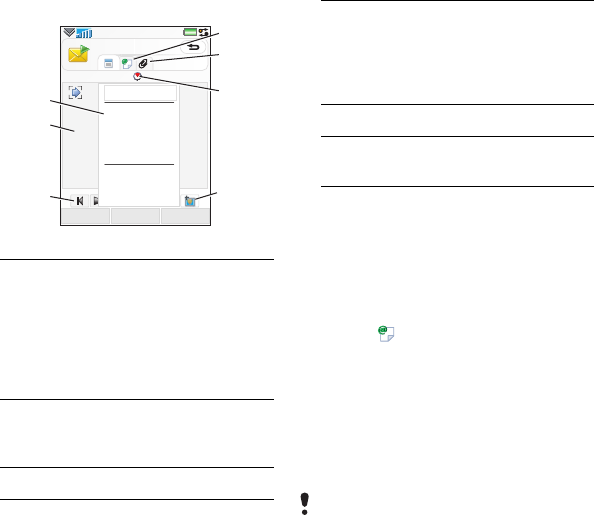
41Messaging
Draft for Sony Ericsson Internal Use Only
An overview of MMS
To create and send an MMS
1From Standby select Main menu >
Messaging.
2Select Create new message >
MMS.
3Add picture, text and sound as
desired.
4Select and fill in the recipient’s
details. To send a message to
several recipients, type a comma
between each address.
5Select Done.
6Select More > Send.
To read an MMS
•Select the new message.
1 Menu options. You can
select a template or what
you want to add to the
message, for example a
picture or sound. (If the
menu is not open, select
Add.)
2
Entry field (on the detail
tab) where you can create
your message
3 Playback keys
4 New page icon
Picture
Text
Scribble
Sound
Video
Take photo
Record sound
Make video
Select Close
1KB
Select template
MMS
1/1 5
2
1
34
5
6
75 Time view icon. Opens a
view where you can adjust
when and for how long
your added items will be
shown
6 Attachments tab
7 Address tab for the
recipient and other details
The first time you open the message
it plays automatically. After that, you
have to use the playback keys to
play it.
42 Messaging
Draft for Sony Ericsson Internal Use Only
Email
Before you use email
To use email you require an
Internet account and will need to
download the necessary email
settings.You can use the Email
wizard available in the phone
under Main menu > Settings >
Messaging > Email accounts or, if
your operator is not supported by
this wizard, do this manually. See
the Help in the phone or
Setting
up Internet, email and MMS
in the
Web guide.
Sending email messages
You can create email messages
from each email account.
To create and send an email
message
1From Standby select Main menu >
Messaging > your email account.
2Select New.
3Tap To: > Select contact and
browse to your contact or tap to
the side of To: and write the email
address of the recipient. To send
a message to several recipients,
type a comma between each
address.
4Select Subject: and enter details.
5Write your message and select
Done.
6Select Send. You will have the
option to send the message
immediately, or to save it to
Outbox.
Receiving email
Email messages are downloaded
from the email server on the
Internet or at your office. You can
download your email manually or
set when your phone should
check for new email.
To download email messages
manually
•From Standby select Main menu >
Messaging > your email account >
More > Get & send.
To download messages
automatically
1From Standby select Main menu >
Settings > Messaging > Email
accounts.
2Select your email account > More
> Scheduled download.
3Mark the Schedule download
check box and enter the times
when you would like to download
email messages.

43Messaging
Draft for Sony Ericsson Internal Use Only
4Select Save.
To forward an email message
1From your email account in
Messaging scroll to the message
you wish to forward.
2Select More > Forward.
Viewing messages
You can choose not to receive
large messages and only to
receive a header.
To download headers
1From Standby select Main menu >
Settings > Messaging > Email
accounts > your email account.
2Select the Inbox tab.
3From Download restrictions, select
Just headers.
4Select Save.
To view messages in full screen
1From Standby select Main menu >
Messaging > your email account.
2Select More > Settings > Always
fullscreen.
Viewing attachments
To view an attachment you need a
viewer for that type of file. Your
phone comes with pre-installed
viewers for Microsoft® Word,
Microsoft® Excel®, Microsoft®
PowerPoint®, and Adobe™
Acrobat™ files.
More about Messaging
Deleting email
You can delete a message both
locally and on your email server.
When you delete it locally, the
message body and attachments
are deleted but the heading
remains. You can download the
message again later with the Get
& send option. When you delete
the message on your server, it is
deleted both in your phone and on
your server.
For IMAP accounts you can also
select Push email and have new email
messages pushed to your phone.
Large attachments increase the size
of an email and the connection time
needed to send it. It is possible to
choose whether to forward the
attachment.

44 Messaging
Draft for Sony Ericsson Internal Use Only
To find a message
1From Standby select Main menu >
Messaging.
2Select More > Find message to
search through the subject lines,
sender details and the text of the
message.
Saving contact details
When you receive a message, you
can save the contact details of the
person who sent the message.
To save a sender’s contact
details
1Select the sender’s phone
number, name or email address in
the details tab or From: in the
address tab.
2Select Add to Contacts.
Disconnecting from the Internet
If your phone is already
connected to the Internet when
you send an email message or an
MMS message it remains
connected after sending.
To disconnect from the Internet
1Select the connection icon, for
example , in the status bar.
2In Connections manager, mark
the check box for your
connection.
3Select Close.
Invitations
If you receive an invitation to an
appointment via an email
message, and you accept, your
calendar will be updated
automatically. You can also reply
to and forward an invitation.
Push email
With push email, email messages
received in your ordinary mailbox
will automatically be sent to your
phone. You can send messages
from your phone, and also use
Calendar and Contacts as if you
were using the ordinary email
application in your computer.
Depending on your operator and
market, you can have a different
push email client installed on your
phone.
IMAP Push email is also available
on your phone.
In an open message,
Find
searches
through the message.

45Messaging
Draft for Sony Ericsson Internal Use Only
To set up IMAP Push email
1From Standby select Main menu >
Settings > Messaging > Email
accounts > your email account.
2Select the Basic tab.
3Select IMAP in Connection type:.
4Mark the Push email check box.
5In Email accounts select More >
Always On push email.
6Mark the Always On check box.
7Select Save.
For more information on push
email contact your operator, your
service provider or your IT
administrator.
For more information about push
email see
More about Messaging
in the Web guide.
46 Media
Draft for Sony Ericsson Internal Use Only
Media
With the Media application you
can handle all your media files,
such as photos and pictures,
music, other audio tracks and
video clips. From Standby select
Main menu > Media to select either
of these main functions:
•Photo – view, edit or send your
photos and pictures.
•Music – categorize and play
your music files or other audio
tracks.
•Video – play and handle your
video clips.
•Settings – change application
orientation, update your
libraries or use the encoding
function.
Transferring media files
Media Manager computer
software and USB drivers are
included on a CD that comes with
the phone. Use Media Manager to
transfer media files from CDs or
your computer to your memory
card in the phone. See the Web
guide for more information.
Updating of media files
The first time you use the Media
application, or when you have
transferred media files to your
phone with the USB cable, your
media libraries automatically
update.
To manually update media files
From Standby select Main menu >
Media > Settings > Update library.
Photos and pictures
Viewing and using pictures
In Photo you can view, send and
use all pictures saved in your
phone memory or on a memory
card. From Standby select Main
menu > Media > Photo to select
either of these viewing options:
•Latest photo - the latest captured
photo/video saved in your phone
or on a memory card.
•Camera album - photos and
videos captured with a camera,
presented in chronological order,
by month.
•Photo tags - view your photos that
you have tagged.

47Media
Draft for Sony Ericsson Internal Use Only
•Pictures - pictures that are not
captured with a camera, such as
preloaded and downloaded
pictures.
To view pictures in a slide show
1From Standby select Main menu >
Media > Photo and select one of
the viewing options.
2Select View > Start to run an
automatic slide show.
3Select one of the pre-defined
sounds or choose your own by
selecting Edit.
To send a picture
1From Standby select Main menu >
Media > Photo and select one of
the four viewing options.
2Select a picture.
3Select More > Send as and
choose to send the file by
Bluetooth™ or in an MMS
message.
Remote screen
You can use a compatible
Bluetooth™ accessory to view
pictures on a remote screen, such
as a TV. For a list of compatible
accessories go to
www.sonyericsson.com/support.
To send pictures to a remote
screen
1From Standby select Main menu >
Media > Photo and select one of
the viewing options.
2Select More and mark Remote
screen.
3Select the desired remote screen.
4Select Yes to enable the
Bluetooth™.
5Open a picture. It will
automatically be sent to the
remote screen.
Editing pictures
Using the editor, you can photo
fix, pan, zoom and rotate your
image. There are also filters for
effects and picture correction.
To edit a picture
1From Standby select Main menu >
Media > Photo.
2Select a picture.
•Select More > Edit.
For more information about the
features and how to use them, see
the Web guide in your phone or on
the Sony Ericsson Webpage.
Make sure you are in full screen play
view and tap the screen if the
slideshow options are not showing.
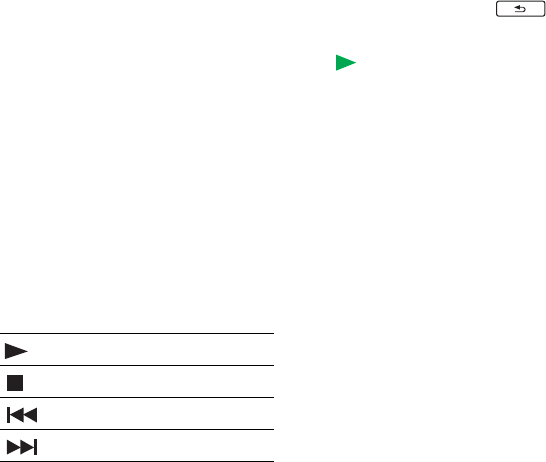
48 Media
Draft for Sony Ericsson Internal Use Only
Music and audio tracks
The music player supports
formats such as MP3, WMA,
WAV, AAC, AAC+ and eAAC+. For
a list of all supported media
formats, see the Web guide.
To play music or other audio
tracks
1From Standby select Main menu >
Media > Music.
2Browse for music/tracks by
Albums, Artists, Tracks,
Compilations, Auto playlists,
Playlists, Audiobooks, Podcasts
and My recordings.
3Scroll to the desired track and
select Play.
Playback controls
To adjust the volume
•Press the Volume keys.
To minimize the music player
•When the music player is open
press and hold down . The
music will continue to play. To
return to the music player, press
in the Status bar.
Playlists
A playlist describes which tracks
to play, and in which order. The
playlist only contains links to the
tracks, so when you remove
tracks from the playlist, the actual
sound files are not deleted.
To create a playlist
•With Media open, select Music >
Playlists > New playlist.
To add songs to a playlist
1With Music open, mark one or
more tracks.
2Select More > Add to playlist.
Auto playlists
The music player creates
automatic playlists based on, for
example, how often you listen to
the tracks. See the Web guide for
more information.
Play
Stop
Skip to previous track
Skip to next track
49Media
Draft for Sony Ericsson Internal Use Only
Bookmarks
If you stop the playback of an
audibook or a podcast channel, a
bookmark is automatically set on
this position. For more
information, see Media in the Web
guide.
Video
With Video, you can watch clips
stored on your phone. Video can
play MPEG-4, H.263, H.264,
WMV9 and Real Video formats.
To play a video clip
1From Standby select Main menu >
Media > Video.
2Navigate to the clip you want to
watch and select Play.
Playback controls
During playback, you can use the
playback controls. See Playback
controls on page 48.
To move within a video clip
•Tap on the progress bar.
To change screen orientation
•During playback, tap the screen in
the video playback area to switch
between landscape and portrait
view.
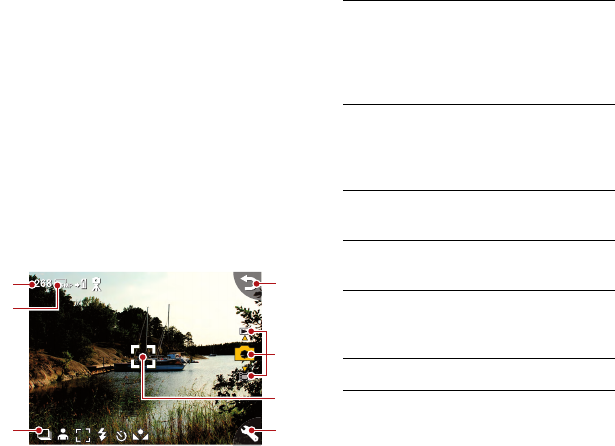
50 Camera
Draft for Sony Ericsson Internal Use Only
Camera
The 3.2 megapixel camera can
take both still pictures and video
clips. You can store them in the
phone or send them as MMS.
Exposure control is automatic and
in poor light conditions you can
use the camera light.
To take a picture or a video clip
1Press the camera key to activate
the camera.
2Change the settings if necessary.
3Press the camera key to capture
the picture.
Use the volume keys to zoom in
and out. Use the left and right
navigation keys to change the
brightness.
M
6
5
4
7
1
2
3
1Use the navigation keys up
and down to choose
between picture mode,
video mode or view mode.
Selected mode is yellow
2 Press once to change the
most often used settings.
Press twice to access more
settings.
3 Overview of the current
temporary settings
4 Overview of the basic
settings
5 The remaining number of
pictures for the current
settings
6 Go back to previous view
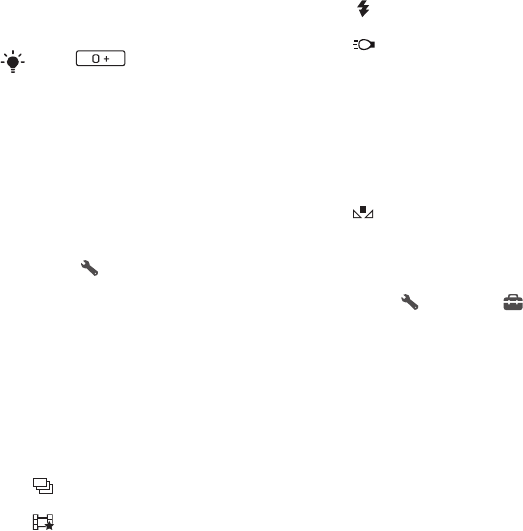
51Camera
Draft for Sony Ericsson Internal Use Only
Changing the Camera
settings
Most of the settings you make will
remain until you change them,
even if you have switched the
camera or your phone off.
To change the most used
settings
1Press once to open the list of
settings.
2Select the required setting to see
the options for this setting.
3Select an option to change the
setting.
The available settings will vary
depending on whether picture or
video mode is selected and what
the setting is set to. The settings
are:
To access more settings
1Press and then (at the
same position) to access more
settings.
2Select the setting to change.
Available camera settings are:
•Picture size - select what picture
size to use.
•Self timer - select On to take
pictures and clips with a time
delay.
•Effects - set and view different
effects before you take a picture
•Picture quality - select a quality
level.
Press to see how you can use
the keypad keys as shortcuts for
some of the most frequently used
settings. Press the key again to
remove the description.
or
Shoot mode – select what
sort of pictures or video clips
to take.
or
Flash or Light – select On to
enable the photo light.
Self timer - select On to take
pictures with a time delay.
Scenes - select On to make
the camera more light
sensitive in poor light
conditions.
White balance – select an
option that matches the
lighting conditions.
52 Camera
Draft for Sony Ericsson Internal Use Only
•Microphone - select Off to turn off
sound recording.
•Auto review - show the picture or
video clip automatically after it
has been taken.
•Save to - select if pictures and
clips will be saved to the memory
card or the phone memory. If you
select Memory Stick preferred they
will be stored on the phone
memory when there is no room
left on the memory card.
•Shutter sound - select (or mute) a
shutter sound.
•Reset - restore the settings to their
default value.
To manage pictures and video
clips
1Select More.
2Select the required command
from the menu that appears.
Viewer
You can view the pictures or video
clips you have captured and also
manage them in several ways.
Select More to open a menu with
viewer options.
Using Tags you can categorize the
pictures or video clips and sort
them into different photo tags.
See Photos and pictures on page
46 for more information about the
viewer.
To send a picture or video clip as
an MMS
1In the viewer select More > Send
as to launch Messaging and insert
the picture or clip into an MMS.
2Follow the instructions in the
phone. See also MMS on page
40.

53Entertainment
Draft for Sony Ericsson Internal Use Only
Entertainment
PlayNow™
PlayNow™ is an entertainment
download service. You can
preview content before purchase.
Before you use PlayNow™
To use PlayNow™ you need an
Internet connection. See
Setting
up Internet, email and MMS
in the
Web guide.
Previewing content
You can download a preview
sample for most content available
at PlayNow™ before deciding to
purchase.
To preview PlayNow™ content
1From Standby select Main menu >
Entertainment > PlayNow™.
2Select Preview or Play for the
content you wish to preview.
Purchasing content
When purchasing content from
PlayNow™, the cost of this
service will be displayed in your
phone. The cost will be debited to
your prepay card or your phone
bill.
To purchase PlayNow™ content
•Select Buy next to the content you
want to purchase and follow the
on-screen instructions.
FM radio
To listen to the radio you need to
insert the handsfree, since the
radio uses the handsfree cable as
antenna. However, you can still
listen to the sound through the
speaker or through a Bluetooth™
connected headset.
To listen to the radio
1Connect the handsfree to the
phone.
2From Standby select Main menu >
Entertainment > FM radio.
To automatically find and store
radio channels
•From Standby select Main menu >
Entertainment > FM radio > More >
Auto store.
This service is not available in all
countries/regions.
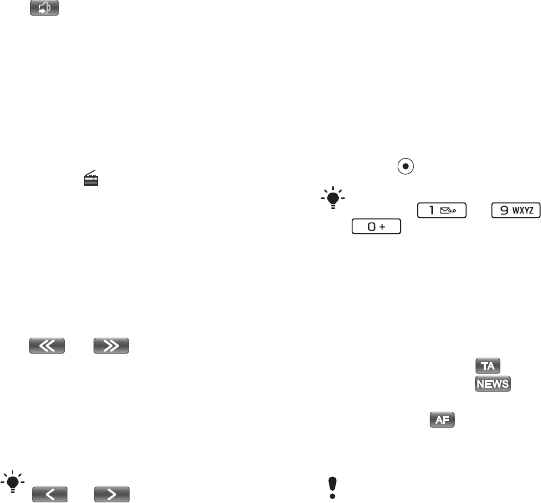
54 Entertainment
Draft for Sony Ericsson Internal Use Only
To transfer the sound
•When the FM radio is open select
and select, for example, the
built-in speaker or a Bluetooth™
headset.
To minimize the radio
•When FM radio is open press the
back key. The radio will continue
playing in the background.
To return to the radio
•Select in the status bar.
To turn the radio off
•When the FM radio is open select
Off.
Tuning and memory presets
To search for radio channels
•When FM radio is open select
or .
To tune manually
1When FM radio is open select
More > Set frequency.
2Enter the frequency using the
keys.
To store a memory preset
1When FM radio is open tune to the
desired channel and select More >
Save.
2Select a preset number between 1
and 20 and select Insert.
To recall a memory preset
1When FM radio is open select
Presets.
2Scroll to the desired channel and
press .
RDS (Radio Data System)
The RDS functionality lets you set
the radio to automatically switch
to a channel when it is
broadcasting a Traffic
announcement, , or News
announcement, . The radio
can also re-tune to the Alternative
frequency that gives the best
reception for the station you have
selected.
You can also press and hold down
or to change the
frequency in 0.1 MHz steps.
You can use presets 1 to 10 by
pressing to and
. Press and hold down to
store, press briefly to recall.
Not all radio channels transmit RDS
information.

55Entertainment
Draft for Sony Ericsson Internal Use Only
To access RDS settings
•When FM radio is open select
More > Settings > RDS options.
TrackID™
You can use TrackID™ to find out
the name of a song. You record a
few seconds of music using the
microphone or from the built-in
FM radio. The sample is then sent
to the TrackID™ database. If a
match is found you will see the
name of the artist, the album and
the title of the song. The
TrackID™ service is free, but your
service provider may charge for
the data traffic.
Before you use TrackID™
To use TrackID™ you need an
Internet connection. See
Setting
up Internet, email and MMS
in the
Web guide.
To identify a song using the
microphone
1From Standby select Main menu >
Entertainment > TrackID™.
2Hold the phone close to the
speaker and select Start.
To identify a song played on the
FM radio
•When the radio is open, tap .
This service is not available in all
countries/regions.

56 Connectivity
Draft for Sony Ericsson Internal Use Only
Connectivity
To exchange information between
your phone and another device
you can use, for example, a USB
or a Bluetooth™ connection.
PC Suite
When connecting your phone to a
computer, certain tasks require
that you have Sony Ericsson PC
Suite installed on your computer.
Install it from the CD delivered
with your phone or go to
www.sonyericsson.com/support
for the latest version.
You can use PC Suite for many
things, including synchronizing
phone data with Microsoft®
Outlook® in your computer or
making backups of phone data.
See
PC Suite
in the Web guide for
more information.
PC Suite requires a USB cable
connection, but for certain
applications you can alternatively
use a Bluetooth connection.
USB connection
With a USB connection you can,
for example, transfer files between
your phone and a computer,
synchronize and make backups of
phone data.
When you connect your phone
and computer using the USB
cable two options appear, File
transfer mode and Phone mode.
File transfer mode
In file transfer mode you can
transfer files to and from your
computer substantially faster
compared to phone mode.
However, in file transfer mode
Microsoft® Windows® Explorer
will only show the memory card (if
inserted).
To transfer files in file transfer mode
you do not need PC Suite installed on
your computer. For phone mode, PC
Suite is required.
Do not remove the USB cable from
your phone or computer during file
transfer as this may cause a loss of
data.

57Connectivity
Draft for Sony Ericsson Internal Use Only
To use file transfer mode
1Connect the USB cable to your
phone and computer.
2Phone: Select File transfer.
3Computer: Wait until the memory
card appears as an external disk,
“PHONE CARD”, in Windows
Explorer.
4Use Windows Explorer as usual to
transfer files between phone and
computer.
To disconnect the phone safely
from your computer
1Computer: Right-click the
removable disk icon in Windows
Explorer and select
Eject
.
2Phone: Remove the USB cable
from your phone.
Phone mode
In phone mode you can use your
computer to synchronize contacts
and calendar items, transfer files,
use the phone as a modem and
more. Applications supported in
phone mode include:
•Synchronization
•File Manager
•Mobile Networking Wizard
•Backup Manager
•Download Language
•Application Installer
To use phone mode
1Computer: Install the
Sony Ericsson PC Suite software.
2Select
Start/Programs/Sony
Ericsson/Sony Ericsson PC Suite
.
The application starts.
3Connect the USB cable to your
phone and computer.
4Phone: Select Phone mode.
5Computer: Wait while Windows
installs the required drivers.
Synchronization
To synchronize your phone using
PC Suite
1Connect the USB cable to your
phone and computer.
2Phone: Select Phone mode.
3Computer: Start PC Suite.
4Wait until your phone is
connected, that is, the
Synchronize Now
button turns
green.
5When you have made all the
synchronization settings, click
Synchronize Now
.
All phone mode applications are
marked with green in PC Suite. Only
synchronization is described here. For
other applications, see PC Suite in the
Web guide.

58 Connectivity
Draft for Sony Ericsson Internal Use Only
Bluetooth connection
To turn on Bluetooth connection
1From Standby select Main menu >
Settings > Connectivity >
Bluetooth.
2Select the Settings tab and
mark the Bluetooth On check box.
Pairing
For all tasks, except for a single
file transfer, it is necessary to set
up a permanent and trusted
relationship between your phone
and the other device. This is
called pairing (or bonding).
To pair with another Bluetooth
device
1From Standby select Main menu >
Settings > Connectivity >
Bluetooth.
2Select the Devices tab > New
device.
3Select the device in the list.
4If you are asked to, enter the
passcode (also called passkey).
Connections manager
Connections manager is where
you control your Internet
connections. You can open and
close connections, and you can
reset the logs for the connections.
To open Connections manager
•From Standby select Main menu >
Organizer > Connections mgr.
To reset logs
1From Standby select Main menu >
Organizer > Connections mgr.
2Select the log you want to reset.
3Select More > Reset log.
Wap push
To set up your phone to handle
incoming WAP push messages
1From Standby select Main menu >
Settings > Messaging > WAP push.
2Select Automatically to receive
Wap push service loading
messages without being
prompted.
59Connectivity
Draft for Sony Ericsson Internal Use Only
Certificate manager and
Java certificates
Digital certificates are used to
verify the origin of the Web pages
you visit or any software you
install.
To view user and CA certificates
in your phone
•From Standby select Main menu >
Settings > Security > Certificate
manager.
To view Java certificates in your
phone
•From Standby select Main menu >
Settings > Security > Java
certificates.

60 More features
Draft for Sony Ericsson Internal Use Only
More features
Managing files and
applications
File manager
With File manager you can view,
rename, copy, move and delete
files and folders in the phone
memory and on the memory card.
The File manager view has two
tabs – the tab for the phone
memory and the tab for the
memory card.
To open File manager
•From Standby select Main menu >
Organizer > File manager.
Protected files
Downloaded or received files may
be copyright-protected.
Copyright-protection may prevent
content from being copied,
modified or transferred. If a file is
copyright-protected is
displayed next to the file name. If
the key symbol is crossed the file
has no valid licence, for example,
the licence may have expired or
there is a pending licence for the
file.
Transferring files from a
computer
You can access a memory card in
the phone as a USB mass storage
device from a computer. This way
you can browse the memory card
folders and transfer files to them.
Launching media files
You can launch media files
directly from File manager by
selecting them.
Renaming memory cards
You can rename the memory
card.
To rename a memory card
1From Standby select Main menu >
Organizer > File manager.
2Select More > Device > Format
Memory Stick > Rename.
Formatting memory cards
To format a memory card
1From Standby select Main menu >
Organizer > File manager.
2Select More > Device > Format
Memory Stick > Format.
All information on the memory card
will be deleted during formatting.

61More features
Draft for Sony Ericsson Internal Use Only
Installing applications
Install applications and other
content you use often, for
example, ringtones in the phone
memory since the memory card is
sometimes unavailable when the
phone is connected to a
computer.
To install an application
1From Standby select Main menu >
Settings > General > Install.
2Select the application and choose
Details to view information about
the certificate.
3If the certificate details are OK,
select Install and follow the
instructions in the phone. The
application is installed in the
Entertainment folder.
Removing applications
Sometimes it is necessary to
remove installed applications to
free up storage space.
To remove an application
1From Standby select Main menu >
Settings > General > Uninstall.
2Select the application and select
Uninstall > Yes.
Master reset
To reset the phone
1From Standby select Main menu >
Settings > General > Master reset.
2If you want to keep installed
applications, unmark Delete all
user installed applications.
3Select Delete > Yes.
4Enter the phone lock code and
select Done.
In
Main menu > Entertainment >
More applications
there are links to
additional applications for your
phone. Some of the applications are
free of charge or free to try out.
All user data, as well as preinstalled
media files (including, for example,
backgrounds, ringtones and pictures),
will be deleted and factory settings
restored.
If you back up your user data using
Sony Ericsson PC Suite, you can
restore it after a master reset.
62 More features
Draft for Sony Ericsson Internal Use Only
Power save
To save power, you can set the
display to go blank after a period
of inactivity.
To enable power save
1From Standby select Main menu >
Settings > Display > Backlight.
2Mark the Power save enabled
check box.
Screen saver
You can use a picture as a screen
saver.
To set a screen saver
•From Standby select Main menu >
Settings > Display > Screen saver.
•Select Open and choose a type.
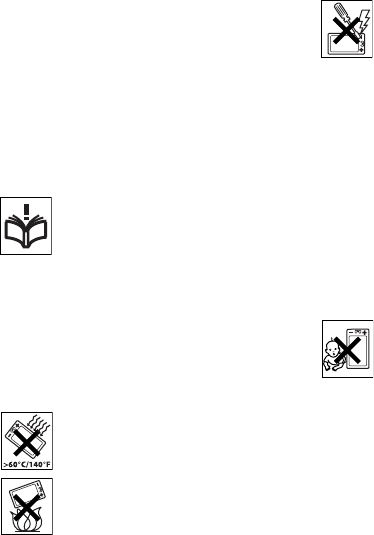
63Important information
Draft for Sony Ericsson internal use only
Important information
Sony Ericsson Consumer Web site
On
www.sonyericsson.com/support
there is a support section where help
and tips are only a few clicks away.
Here you will find the latest computer
software updates and tips on how to
use your phone more efficiently.
Guidelines for Safe and Efficient Use
Please follow these guidelines. Failure
to do so might entail a potential
health risk or product malfunction. If
in doubt as to its proper function,
have the product checked by a
certified service partner before
charging or using it.
Recommendations for care and safe
use of our products
• Handle with care and keep in a clean and dust-free
place.
•Warning! May explode if disposed of in fire.
• Do not expose your product to liquid or moisture or
excess humidity.
• Do not expose to extreme
temperatures. Do not expose the
battery to temperatures above +60°C
(+140°F).
• Do not expose to flames or lit tobacco
products.
• Do not drop, throw or try to bend your
product.
• Do not paint or attempt to
disassemble or modify your product.
Only Sony Ericsson authorized
personnel should perform service.
• Consult with authorized medical staff
and the instructions of the medical
device manufacturer before using your product
near pacemakers or other medical devices or
equipment.
• Discontinue use of electronic devices or disable the
radio transmitting functionality of the device where
required or requested to do so.
• Do not use where a potentially explosive
atmosphere exists.
• Do not place your product or install wireless
equipment in the area above an air bag in your car.
• Caution: Cracked or broken displays may create
sharp edges or splinters that could be harmful upon
contact.
• Do not use your Bluetooth Headset in positions
where it is uncomfortable or will be subject to
pressure.
Children
Warning! Keep out of the reach of
children. Do not allow children to play
with mobile phones or accessories.
They could hurt themselves or others.
Products may contain small parts that could
become detached and create a choking hazard.
Power supply (Charger)
Connect the charger to power sources as marked
on the product. Do not use outdoors or in damp
areas. Do not alter or subject the cord to damage
or stress. Unplug the unit before cleaning it. Never
alter the plug. If it does not fit into the outlet, have a
proper outlet installed by an electrician. When
power supply is connected there is a small drain of
power. To avoid this small energy waste,
disconnect the power supply when the product is
fully charged.

64 Important information
Draft for Sony Ericsson internal use only
Use of charging devices that are not Sony Ericsson
branded may impose increased safety risks.
Battery
New or idle batteries can have short-term reduced
capacity. Fully charge the battery before initial use.
Use for intended purpose only. Charge the battery
in temperatures between +5°C (+41°F) and +45°C
(+113°F). Do not put the battery into your mouth.
Do not let the battery contacts touch another metal
object. Turn off the product before removing the
battery. Performance depends on temperatures,
signal strength, usage patterns, features selected
and voice or data transmissions. Only Sony
Ericsson service partners should remove or replace
built-in batteries. Use of batteries that are not Sony
Ericsson branded may pose increased safety risks.
Note: The environmental protection period (EPUP)
of battery is 5 years.
Personal medical devices
Mobile phones may affect implanted medical
equipment. Reduce risk of interference by keeping
a minimum distance of 15 cm (6 inches) between
the phone and the device. Use the phone at your
right ear. Do not carry the phone in your breast
pocket. Turn off the phone if you suspect
interference. For all medical devices, consult a
physician and the manufacturer.
Driving
Some vehicle manufacturers forbid the use of
phones in their vehicles unless a handsfree kit with
an external antenna supports the installation.
Check with your vehicle manufacturer's
representative to be sure that your mobile phone or
Bluetooth handsfree will not affect the electronic
systems in your vehicle. Full attention should be
given to driving at all times and local laws and
regulations restricting the use of wireless devices
while driving must be observed.
GPS/Location based functions
Some products provide GPS/Location based
functions. Location determining functionality is
provided "As is" and "With all faults". Sony
Ericsson does not make any representation or
warranty as to the accuracy of such location
information.
Use of location-based information by the device
may not be uninterrupted or error free and may
additionally be dependent on network service
availability. Please note that functionality may be
reduced or prevented in certain environments such
as building interiors or areas adjacent to buildings.
Caution: Do not use GPS functionality in a manner
which causes distraction from driving.
Emergency calls
Calls cannot be guaranteed under all conditions.
Never rely solely upon mobile phones for essential
communications. Calls may not be possible in all
areas, on all networks, or when certain network
services and/or phone features are used.
Antenna
Use of antenna devices not marketed by Sony
Ericsson could damage your phone, reduce
performance, and produce SAR levels above the
established limits. Do not cover the antenna with
your hand as this affects call quality, power levels
and can shorten talk and standby times.
Radio frequency (RF) exposure and
Specific Absorption Rate (SAR)
When your phone or Bluetooth handsfree is turned
on, it emits low levels of radio frequency energy.
International safety guidelines have been
developed through periodic and thorough
evaluation of scientific studies. These guidelines
establish permitted levels of radio wave exposure.
The guidelines include a safety margin designed to
assure the safety of all persons and to account for
any variations in measurements.

65Important information
Draft for Sony Ericsson internal use only
Specific Absorption Rate (SAR) is used to measure
radio frequency energy absorbed by the body when
using a mobile phone. The SAR value is determined
at the highest certified power level in laboratory
conditions, but because the phone is designed to
use the minimum power necessary to access the
chosen network, the actual SAR level can be well
below this value. There is no proof of difference in
safety based on difference in SAR value.
Products with radio transmitters sold in the US
must be certified by the Federal Communications
Commission (FCC). When required, tests are
performed when the phone is placed at the ear and
when worn on the body. For body-worn operation,
the phone has been tested when positioned a
minimum of 15 mm from the body without any
metal parts in the vicinity of the phone or when
properly used with an appropriate Sony Ericsson
accessory and worn on the body.
For more information about SAR and radio
frequency exposure go to:
www.sonyericsson.com/
cn.
Malware
Malware (short for malicious software) is software
that can harm your mobile phone or other
computers. Malware or harmful applications can
include viruses, worms, spyware, and other
unwanted programs. While your device does
employ security measures to resist such efforts,
Sony Ericsson does not warrant or represent that
your device will be impervious to introduction of
malware. You can however reduce the risk of
malware attacks by using care when downloading
content or accepting applications, refraining from
opening or responding to messages from unknown
sources, using trustworthy services to access the
Internet, and only downloading content to your
mobile phone from known, reliable sources.
Accessories
Use only Sony Ericsson branded original
accessories and certified service partners. Sony
Ericsson does not test third-party accessories.
Accessories may influence RF Exposure, radio
performance, sound loudness, electric safety and
other areas. Third-party accessories and parts may
pose a risk to your health or safety or decrease
performance.
Disposal of old electrical
and electronic equipment
Electronic equipment and batteries
should not be included as household
waste but should be left at an
appropriate collection point for recycling. This
helps prevent potential negative consequences for
the environment and human health. Check local
regulations by contacting your local city office, your
household waste disposal service, the shop where
you purchased the product or calling a Sony
Ericsson Call Center.
Disposing of the battery
Check local regulations or call a Sony
Ericsson Call Center for information.
Never use municipal waste.
Declaration of substances
When this product is operated under the conditions
in the product manual, the environmental
protection period (EPUP) is 20 years.

66 Important information
Draft for Sony Ericsson internal use only
Memory Card
If your product comes complete with a removable
memory card, it is generally compatible with the
mobile phone purchased but may not be
compatible with other devices or the capabilities of
their memory cards. Check other devices for
compatibility before purchase or use. If your
product is equipped with a memory card reader,
check memory card compatibility before purchase
or use.
Memory cards are generally formatted prior to
shipping. To reformat the memory card, use a
compatible device. Do not use the standard
operating system format when formatting the
memory card on a PC. For details, refer to the
operating instructions of the device or contact
customer support.
Warning!
If your device requires an adapter for insertion into
the mobile phone or another device, do not insert
the card directly without the required adapter.
Precautions on Memory Card Use
• Do not expose the memory card to moisture.
• Do not touch terminal connections with your hand
or any metal object.
• Do not strike, bend, or drop the memory card.
• Do not attempt to disassemble or modify the
memory card.
• Do not use or store the memory card in humid or
corrosive locations or in excessive heat such as a
closed car in summer, in direct sunlight or near a
heater, etc.
• Do not press or bend the end of the memory card
adapter with excessive force.
• Do not let dust or foreign objects get into the insert
port of any memory card adapter.
• Check you have inserted the memory card
correctly.
• Insert the memory card as far as it will go into any
memory card adapter needed. The memory card
may not operate properly unless fully inserted.
• We recommend that you make a backup copy of
important data. We are not responsible for any loss
or damage to content you store on the memory
card.
Part Name Toxic or hazardous substances
Lead
(Pb)
Mercury
(Hg)
Cadmium
(Cd)
Hexavalent
chromium
(Cr6+)
Polybrominated
biphenyls
(PBB)
Polybrominated
diphenyl ethers
(PBDE)
Phone X O O O O O
Battery X O O O O O
Accessories
and charger
XO O OO O
O: Indicates that this toxic or hazardous substance contained in all of the homogeneous materials for this
part is below the limit requirement in SJ/T 11363-2006.
X: Indicates that this toxic or hazardous substance contained in at least one of the homogeneous materials
used for this part is above the limit requirement in SJ/T 11363-2006.( Currently there are no alternative
technologies available)
67Important information
Draft for Sony Ericsson internal use only
• Recorded data may be damaged or lost when you
remove the memory card or memory card adapter.
Turn off the power while formatting, reading or
writing data. Do not use the memory card in
locations subject to static electricity or high
electrical field emissions.
Protection of personal information
Erase personal data before disposing of the
product. To delete data, perform a master reset.
Deleting data from the phone memory does not
ensure that it cannot be recovered. Sony Ericsson
does not warrant against recovery of information
and does not assume responsibility for disclosure
of any information even after a master reset.
Loudness warning!
Avoid volume levels that may be harmful to your
hearing.
End User Licence Agreement
Software delivered with this device and its media is
owned by Sony Ericsson Mobile Communications
AB, and/or its affiliated companies and its suppliers
and licensors.
Sony Ericsson grants you a non-exclusive limited
license to use the Software solely in conjunction
with the Device on which it is installed or delivered.
Ownership of the Software is not sold, transferred
or otherwise conveyed.
Do not use any means to discover the source code
or any component of the Software, reproduce and
distribute the Software, or modify the Software.
You are entitled to transfer rights and obligations to
the Software to a third party, solely together with
the Device with which you received the Software,
provided the third party agrees in writing to be
bound by the terms of this License.
This license exists throughout the useful life of this
Device. It can be terminated by transferring your
rights to the Device to a third party in writing.
Failure to comply with any of these terms and
conditions will terminate the license immediately.
Sony Ericsson and its third party suppliers and
licensors retain all rights, title and interest in and to
the Software. Sony Ericsson, and, to the extent that
the Software contains material or code of a third
party, such third party, shall be entitled third party
beneficiaries of these terms.
This license is governed by the laws of Sweden.
When applicable, the foregoing applies to statutory
consumer rights.
In the event Software accompanying or provided in
conjunction with your device is provided with
additional terms and conditions, such provisions
shall also govern your possession and usage of the
Software.
Limited warranty
Sony Ericsson Mobile Communications AB, Nya
Vattentornet, SE-221 88 Lund, Sweden (Sony
Ericsson), or its local affiliated company, provides
this Limited Warranty for your mobile phone,
original accessory delivered with your mobile
phone, and/or your mobile computing product
(hereinafter referred to as "Product").
Should your Product need warranty service, please
return it to the dealer from whom it was purchased,
or contact your local Sony Ericsson Call Center
(national rates may apply) or visit
www.sonyericsson.com/cn t
o get further
information.
WHAT WE WILL DO
If, during the warranty period, this Product fails to
operate under normal use and service, due to
defects in design, materials or workmanship, Sony
Ericsson authorized distributors or service partners,
in the country/region* where you purchased the
Product, will, at their option, either repair or replace
the Product in accordance with the terms and
conditions stipulated herein.
68 Important information
Draft for Sony Ericsson internal use only
Sony Ericsson and its service partners reserve the
right to charge a handling fee if a returned Product
is found not to be under warranty according to the
conditions below.
Please note that some of your personal settings,
downloads and other information may be lost when
your Sony Ericsson Product is repaired or replaced.
At present Sony Ericsson may be prevented by
applicable law, other regulation or technical
restrictions from making a backup copy of certain
downloads. Sony Ericsson does not take any
responsibility for any lost information of any kind
and will not reimburse you for any such loss. You
should always make backup copies of all the
information stored on your Sony Ericsson Product
such as downloads, calendar and contacts before
handing in your Sony Ericsson Product for repair or
replacement.
Conditions
1 This Limited Warranty is valid only if the original
proof of purchase for this Product issued by a Sony
Ericsson authorized dealer specifying the date of
purchase and serial number**, is presented with the
Product to be repaired or replaced. Sony Ericsson
reserves the right to refuse warranty service if this
information has been removed or changed after the
original purchase of the Product from the dealer.
2 If Sony Ericsson repairs or replaces the Product,
the repair for the defect concerned, or the replaced
Product shall be warranted for the remaining time
of the original warranty period or for ninety (90)
days from the date of repair, whichever is longer.
Repair or replacement may involve the use of
functionally equivalent reconditioned units.
Replaced parts or components will become the
property of Sony Ericsson.
3 This warranty does not cover any failure of the
Product due to normal tear and wear, or due to
misuse, including but not limited to use in other
than the normal and customary manner, in
accordance with the Sony Ericsson instructions for
use and maintenance of the Product. Nor does this
warranty cover any failure of the Product due to
accident, software or hardware modification or
adjustment, acts of God or damage resulting from
liquid.
A rechargeable battery can be charged and
discharged more than a hundred times. However, it
will eventually wear out – this is not a defect and
corresponds to normal wear and tear. When the
talk-time or standby time is noticeably shorter, it is
time to replace your battery. Sony Ericsson
recommends that you use only batteries and
chargers approved by Sony Ericsson.
Minor variations in display brightness and colour
may occur between the phones. There may be tiny
bright or dark dots on the display. These are called
defective pixels and occur when individual dots
have malfunctioned and can not be adjusted. Two
defective pixels are deemed acceptable.
Minor variations in the appearance of the camera
image may occur between phones. This is not
uncommon in digital cameras and does not mean
that the camera is defective in any way.
4 Since the cellular system on which the Product is to
operate is provided by a carrier independent from
Sony Ericsson, Sony Ericsson will not be
responsible for the operation, availability, coverage,
services or range of that system.
5 This warranty does not cover Product failures
caused by installations, modifications, or repair or
opening of the Product performed by a non-Sony
Ericsson authorised person.
6 The warranty does not cover Product failures which
have been caused by use of accessories or other
peripheral devices which are not Sony Ericsson
branded original accessories intended for use with
the Product.

69Important information
Draft for Sony Ericsson internal use only
7 Tampering with any of the seals on the Product will
void the warranty.
8 THERE ARE NO EXPRESS WARRANTIES,
WHETHER WRITTEN OR ORAL, OTHER THAN
THIS PRINTED LIMITED WARRANTY. ALL
IMPLIED WARRANTIES, INCLUDING WITHOUT
LIMITATION THE IMPLIED WARRANTIES OF
MERCHANTABILITY OR FITNESS FOR A
PARTICULAR PURPOSE, ARE LIMITED TO THE
DURATION OF THIS LIMITED WARRANTY. IN
NO EVENT SHALL SONY ERICSSON OR ITS
LICENSORS BE LIABLE FOR INCIDENTAL OR
CONSEQUENTIAL DAMAGES OF ANY NATURE
WHATSOEVER, INCLUDING BUT NOT LIMITED
TO LOST PROFITS OR COMMERCIAL LOSS; TO
THE FULL EXTENT THOSE DAMAGES CAN BE
DISCLAIMED BY LAW.
Some countries/regions/states do not allow the
exclusion or limitation of incidental or
consequential damages, or limitation of the
duration of implied warranties, so the preceding
limitations or exclusions may not apply to you.
The warranty provided does not affect the
consumer's statutory rights under applicable
legislation in force, nor the consumer’s rights
against the dealer arising from their sales /
purchase contract.
* In some countries/regions additional information
is requested. If so, this is clearly shown on the valid
proof of purchase.
FCC Statement
This device complies with Part 15 of
the FCC rules. Operation is subject to
the following two conditions:
(1) This device may not cause
harmful interference, and
(2) This device must accept any interference
received, including interference that may cause
undesired operation.
Any change or modification not expressly approved
by Sony Ericsson may void the user's authority to
operate the equipment.
This equipment has been tested and found to
comply with the limits for a Class B digital device,
pursuant to Part 15 of the FCC Rules. These limits
are designed to provide reasonable protection
against harmful interference in a residential
installation. This equipment generates, uses and
can radiate radio frequency energy and, if not
installed and used in accordance with the
instructions, may cause harmful interference to
radio communications. However, there is no
guarantee that interference will not occur in a
particular installation.
If this equipment does cause harmful interference
to radio or television reception, which can be
determined by turning the equipment off and on,
the user is encouraged to try to correct the
interference by one or more of the following
measures:
-- Reorient or relocate the receiving antenna.
-- Increase the separation between the equipment
and receiver.
-- Connect the equipment into an outlet on a circuit
different from that to which the receiver is
connected.
-- Consult the dealer or an experienced radio/TV
technician for help.
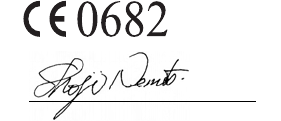
70 Important information
Draft for Sony Ericsson internal use only
Industry Canada Statement
This device complies with RSS-210 of Industry
Canada.
Operation is subject to the following two
conditions: (1) this device may not cause
interference, and
(2) this device must accept any interference,
including interference that may cause undesired
operation of the device.
This Class B digital apparatus complies with
Canadian ICES-003.
Cet appareil numérique de la classe B est conforme
à la norme NMB-003 du Canada.
Declaration of Conformity for
G700c
We, Sony Ericsson Mobile Communications AB of
Nya Vattentornet
SE-221 88 Lund, Sweden
declare under our sole responsibility that our
product
Sony Ericsson type FAB-1022015-BV
and in combination with our accessories, to which
this declaration relates is in conformity with the
appropriate standards EN 301 511:V9.0.2,
EN 300 328:V1.7.1, EN 301 489-7:V1.3.1,
EN 301 489-17:V1.2.1, and EN 60950-1:2006,
following the provisions of, Radio Equipment and
Telecommunication Terminal Equipment Directive
1999/5/EC.
We fulfil the requirements of the R&TTE Directive
(1999/5/EC).
Lund, February 2008
Shoji Nemoto,
Head of Product Business Group GSM/UMTS
71Index
Draft for Sony Ericsson Internal Use Only
Index
B
Backup of phone data ...................56
Battery ............................................. 9
Bluetooth™ wireless technology ..58
C
Call log ..........................................33
Camera ..........................................50
Certificates ....................................59
Connections manager ...................58
Contacts ........................................34
E
Email ..............................................42
Emergency call ..............................32
Entering
symbols ..................................25
Example
using keypad prediction .........24
using multitap ........................24
using Pinyin input ...................25
using Stroke input ..................25
using wild card key ................25
F
File manager .................................. 60
File transfer mode ......................... 56
Flight mode ................................... 14
FM radio ........................................ 53
Folders in messaging .................... 39
H
Handsfree settings ........................ 33
Handwriting
accented letters ..................... 28
Chinese characters ................ 26
Chinese punctuations ............ 27
extended characters .............. 28
latin letters ............................. 27
multi-character recognition .... 29
numbers ................................. 28
special gestures ..................... 29
Handwriting recognition ................ 26
72 Index
Draft for Sony Ericsson Internal Use Only
I
IMEI number .................................. 13
Import contacts ............................. 20
input
text ......................................... 23
Installing applications ................... 61
International call ............................ 31
Internet wizard .............................. 13
K
Keylock ......................................... 13
Keypad prediction
example ................................. 24
M
Main menu .................................... 16
overview ................................. 18
Master reset .................................. 61
Memory card ................................. 21
Messaging ..................................... 39
MMS ............................................. 40
Multitap
example ................................. 24
Music ............................................ 48
N
Navigation ..................................... 15
Notes ............................................. 21
O
On/off ............................................ 14
P
Pairing ........................................... 58
Panels ........................................... 15
PC Suite ........................................ 56
Photo
take ........................................ 50
Picture editor ................................ 47
Pinyin input
example ................................. 25
PlayNow™ .................................... 53
Power save ................................... 62
Protected files ............................... 60
Push email .................................... 44
R
RSS feeds ..................................... 38
S
Screen in text mode ...................... 26
Screen saver ................................. 62
Selecting
text ......................................... 30
Silent mode ................................... 20
SIM card ......................................... 9
Slide show .................................... 47
SMS .............................................. 40
73Index
Draft for Sony Ericsson Internal Use Only
Sounds and alerts .........................20
Speed dial .....................................31
Standby .........................................15
Status bar ......................................19
Stroke input
example .................................25
Switching
input languages ......................25
Pinyin and Stroke ...................24
to handwriting recognition mode
26
to keypad prediction mode ....23
switching
keypad prediction mode ........24
Symbols
entering ..................................25
Synchronization .............................57
T
Text
selection, highlight .................30
Text input ......................................23
switching between Pinyin and
Stroke ......................24
using handwriting recognition 26
using on-screen keypad ........29
text input
using the keypad ................... 23
Torch ............................................. 22
TrackID™ ...................................... 55
Transferring files ............................ 56
U
Update software ............................ 17
Updating software ......................... 17
USB file transfer ............................ 56
V
Video
capture ................................... 50
play ........................................ 49
W
Wap push ...................................... 58
Web browser ................................. 37
Web feeds ..................................... 38
Web guide ....................................... 5
Wild card key
example ................................. 25